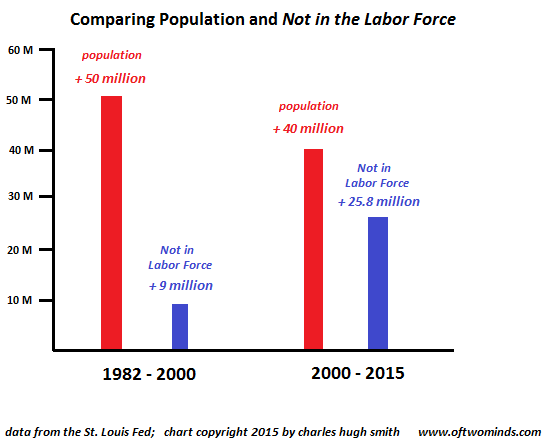Heroic efforts are being made to cloak the stagnation of the U.S. economy. One of these is to shift the unemployed work force from the negative-sounding jobless category to the benign-sounding Not in the Labor Force (NILF) category.
But re-labeling stagnation does not magically transform a stagnant economy.To get a sense of long-term stagnation, let’s look at the data going back 38 years, to 1977.
NOT IN LABOR FORCE (NILF) 1976 to 2015
I’ve selected data from three representative eras:
– The 20-year period from 1977 to 1997, as this encompasses a variety of macro-economic conditions: five years of stagflation and two back-to-back recessions (1977 – 1982), strong growth from 1983 to 1990, a mild recession in 1991, and growth from 1993 to 1997.
– The period of broad-based expansion from 1982 to 2000
– The period 2000 to 2015, an era characterized by bubbles, post-bubble crises and low-growth “recovery”
In all cases, I list the Not in Labor Force (NILF) data and the population of the U.S.
1977-01-01: 61.491 million NILF population 220 million
1997-01-01 67.968 million NILF population 272 million
Population rose 52 million 23.6%
NILF rose 6.477 million 10.5%
1982-07-01 59.838 million NILF (start of boom) population 232 million
2000-07-01 68.880 million NILF (end of boom) population 282 million
Population rose 50 million 21.5%
NILF rose 9.042 million 15.1%
2000-07-01 68.880 million NILF population 282 million
2015-09-01 94.718 million NILF (“recovery”) population 322 million
Population rose 40 million 14.2%
NILF rose 25.838 million 37.5%
Notice how population growth was 23.6% 1977-1997 while growth of NILF was a mere 10.5% As the population grew, job growth kept NILF to a low rate of expansion. While the population soared by 52 million, only 6.5 million people were added to NILF.
In the golden era of 1982 – 2000, population rose 21.5% while NILF expanded by 15%. Job growth was still strong enough to limit NILF expansion. The population grew by 50 million while NILF expanded by 9 million.
But by the present era, Not in the Labor Force expanded by 37.5% while population grew by only 14.2%. This chart shows the difference between the two eras: those Not in the Labor Force soared by an unprecedented 26 million people–a staggering 15.6% of the nation’s work force of 166 million. (Roughly 140 million people have some sort of employment or self-employment, though millions of these earn less than $10,000 a year, so classifying them as “employed” is a bit of a stretch).

This is a stark depiction of underlying stagnation: paid work is not being created as population expands. Those lacking paid work are not just impoverished; they lose the skills and will to work, a loss to the nation in more than economic vitality.
How to forge a career in a stagnant economy:
Get a Job, Build a Real Career and Defy a Bewildering Economy,
a mere $9.95 for the Kindle ebook edition and $18 for the print edition.